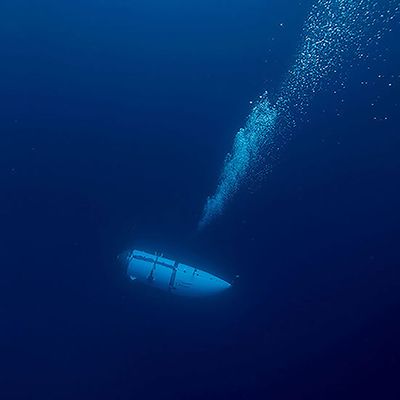
On June 18, an underwater vessel touring the wreck of the RMS Titanic went missing in the North Atlantic shortly after being deployed. As the search for the five passengers onboard dragged on, Twitter memes about the irony of the situation reached royal-funeral levels, and details trickling in about the logistics of the expedition suggested it might not have been a great idea to begin with. By the following Thursday, the U.S. Coast Guard announced that it had located wreckage from the sub, which looked consistent with a “catastrophic” — and evidently fatal — implosion. As crews dredged up the debris this week, the Coast Guard shared another development: They found “presumed human remains” mingled with the mechanical evidence on the seafloor.
Surely, being a regular person uninterested in touring the ruins of 100-year-old naval catastrophes, you have questions. Same. Let’s try and wade through this together, shall we?
.
What was the deal with this submarine?
The missing vessel (called, of all things, the Titan) was not actually a submarine but a submersible, which means it couldn’t power itself into and out of the ocean. Instead, it was deployed and retrieved by a mother ship, which needed some kind of contact with the submersible in order to recover it. The 22-foot submersible, made of carbon fiber and titanium, was operated by a Washington-based private company called OceanGate. The company has been conducting tours of shipwrecks and underwater canyons since 2009 when it was founded by a Princeton grad named Stockton Rush with the purported goal of making deep-sea tourism more accessible. This particular expedition trip, OceanGate’s third to the Titanic wreckage, cost $250,000 per passenger and was scheduled to last eight days with each dive lasting about ten hours between trips to the surface.
.
So, um, what happened?
On June 18, the Titan left a Canadian expedition ship near Newfoundland to go 13,000 feet underwater to the ocean floor, where the wreck of the Titanic is located.
According to the Coast Guard, which helped conduct the search from Boston, the surface ship last had contact with the submersible about an hour and 45 minutes after it was deployed. The Titan was reported overdue for communication about 435 miles south of St. John’s, Newfoundland. Canada and the U.S. sent out armed forces, surface vessels, submarines, sonar buoys, and aircraft to try to locate the ship, searching an area about 900 miles east of Cape Cod that was discouragingly large: twice the size of Connecticut and two and a half miles deep.
Despite initial hope buoyed by “banging sounds” that rescuers heard coming from under the surface, it became clear by June 22 that all five passengers onboard were most likely dead. The Coast Guard announced that one of its search vessels had found a “debris field” about 1,600 feet from the Titanic’s hull, and it was later identified as five pieces of the Titan. In a press conference, Coast Guard admiral John Mauger said the debris was “consistent with a catastrophic implosion of the vessel.” Shortly after the debris was discovered, OceanGate announced in a statement that the company believed the Titan passengers had “sadly been lost.”
The Coast Guard said it planned to demobilize most of its search personnel after discovering the wreck, but Mauger maintained that crews would continue to look for the passengers’ bodies — which they appear to have found within the week. On June 28, the Coast Guard released a statement saying it had received “presumed human remains” from the Marine Board of Investigation, “carefully recovered within the wreckage at the site of the incident.” Those will now be analyzed by medical professionals in the U.S.
As to how investigating agencies found the Titan’s ruins in the first place: According to the Wall Street Journal, the U.S. Navy actually heard what is believed to be the implosion, a few hours after the submersible was deployed. The Navy reportedly started listening for clues of the vessel’s whereabouts as soon as it lost communications, and top-secret underwater microphones normally used to detect enemy submarines picked up “an anomaly consistent with an implosion or explosion in the general vicinity of where the Titan submersible was operating when communications were lost.” The Navy reported the sounds to the Coast Guard, which helped narrow the scope of the search and rescue mission.
.
Who was onboard?
There were five people inside the vessel: OceanGate’s founder, Rush; a billionaire British adventurer named Hamish Harding; the French maritime expert Paul-Henri Nargeolet; and a British Pakistani businessman, Shahzada Dawood, who had brought his 19-year-old son Suleman on the trip. Dawood’s sister, Azmeh, told NBC News that her nephew had been “terrified” about the trip but reluctantly agreed to join his father.
As news from the rescue efforts became increasingly dismal, some watching the crisis from afar unearthed unexpected biographical details about the characters onboard. Rush, for example, was married to a descendant of a couple who died on the Titanic itself. According to the New York Times, archival records show that Rush’s wife, Wendy, is the great-great-granddaughter of Isidor and Ida Straus, two of the wealthiest passengers on the 1912 voyage. (Isidor Straus co-owned Macy’s. Another great-great-grandchild of the Strauses, by the way: King Princess, who described the incident on TikTok as “the ghosts of my ancestors snatching up these bajillionaires.”) Survivors of the tragedy say that Isidor gave up his lifeboat seat to make room for more women and children and that he and Ida stayed on the deck holding each other as the ship went down. James Cameron allegedly included an homage to them in his film Titanic, in which one shot shows an older couple lying in bed together while water rushes into their cabin.
There is also the matter of Brian Szasz, the stepson of the billionaire explorer onboard. Szasz announced on Facebook the day after the vessel went missing that he was attending a Blink-182 show in San Francisco. He acknowledged that going to the concert “might be distasteful,” but said he felt that “my family would want me to be at the blink-182 show as it’s my favorite band and music helps me in difficult times!” He followed this assertion with a series of truly bizarre antics as rescuers searched for his stepfather, including asking an OnlyFans model to sit on him and “please keep my family in your prayers,” later adding, “Ladies I’m single!” He also found himself in a Twitter feud with Cardi B, who criticized him for going to a concert while his stepfather was lost at sea. After Szasz called the rapper “trashy” and “desperate for attention,” Cardi responded that he “was looking for clout along,” adding, “This is why people hate you spoiled brat billionaires.”
.
Back to the ship. Why tour the Titanic?
As is often the case when people pay thousands of dollars to go someplace famously dangerous and unexplored, one question comes to mind: Why? As it turns out, Titanic tours are a pretty lucrative corner of the tourism industry, though they are not without controversy.
The Titanic sank in 1912, but its wreckage wasn’t located until 1985. Since then, researchers, experts, historians, hobbyists, and everyone in between have been paying visits to pillage items from the ship — which is rapidly deteriorating into deep-sea bacteria — both for sale (over 5,000 items have been acquired at auctions) and for conservation efforts. Some people are less interested in getting their hands on a piece of the wreckage than they are in the lore. The first tickets to visit the remains were sold in 1998, and since then, three companies, one of which has worked closely with OceanGate, have conducted similar trips. One truly intrepid couple even got married inside a submarine resting on the bow of the ship. Ah, to be young, in love, and 13,000 feet undersea.
It seems the people onboard the Titan were there for both research and sightseeing purposes. OceanGate’s website detailed a “scientific and technological survey” that was planned once they arrived at the wreck. One of the passengers, Nargeolet, worked at RMS Titanic, Inc., the American company that owns “salvage rights” to the wreckage and shows artifacts from it at museums and other exhibits. Nargeolet had paid more than 35 visits to the disintegrating ship.
.
Could this situation have been avoided?
While rescuers scrambled to locate the Titan, details emerged suggesting the voyage had been pretty dubious to begin with. In 2018, OceanGate filed a lawsuit against a former employee, David Lochridge, whom court records show had been working on a report about the dangers of the Titan’s construction before he was fired.
Lochridge was not the only person concerned about what his lawyer called the “experimental design” of the Titan. That same year, a group of 40-odd marine-exploration leaders, explorers, and oceanographers wrote a letter to OceanGate outlining their concerns about the company’s safety testing and warning that sending the vessel to the Titanic could lead to “negative outcomes from minor to catastrophic.” The crux of everyone’s worries was that Rush, the company’s founder, who was piloting the vessel when it disappeared, apparently refused to have the Titan inspected by an accredited agency. The Marine Technology Society, the group behind the letter, accused Rush of promoting “misleading” information about the expedition by claiming it met the safety standards of a particular risk-assessment company that had no plans to inspect or certify the vessel.
Meanwhile, a video of CBS reporter David Pogue touring the Titan, in which Rush reveals that the entire vessel is controlled by a $30 Logitech game controller, has started circulating online. (Of course, in a more benign form of disaster tourism, the controller immediately sold out on Amazon.) Pogue has been liberally sharing other concerning details about the vessel, which he took to see the Titanic wreckage in 2022. At some point while he was on the surface, Pogue says, the Titan got lost for several hours, though at that time, it still maintained contact. Another hellish tidbit from Pogue via the BBC: The Titan sealed shut from the outside, so even if it had not imploded and somehow surfaced, the passengers would have suffocated unless a crew of experts were there to remove the bolts. Following the news that the passengers were presumed dead, Pogue said, “It is hard to think they are gone like that.”
James Cameron, who’s visited the Titanic wreckage in a submersible 33 times, pointed out the similarities between the Titan and the original Titanic, where, as he recalled, “The captain was repeatedly warned about ice ahead of his ship.” “It’s a very similar tragedy,” he said, “where warnings went unheeded.” Meanwhile Guillermo Sohnlein, one of OceanGate’s cofounders who left the company in 2013, urged the public to “hold off on speculation until we have more data to go on.”
OceanGate has not publicly addressed potential issues with the Titan’s safety. Instead, the company’s statement called the passengers “true explorers who shared a distinct spirit of adventure, and a deep passion for exploring and protecting the world’s oceans.” It added, “We grieve the loss of life and joy they brought to everyone they knew.”
This post has been updated.


